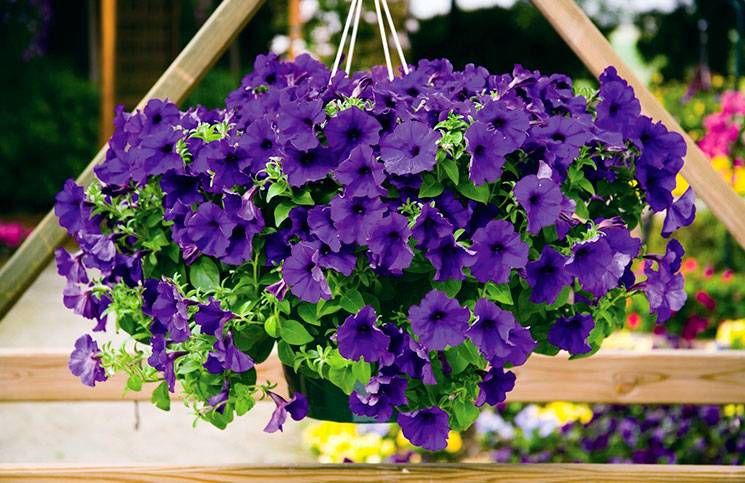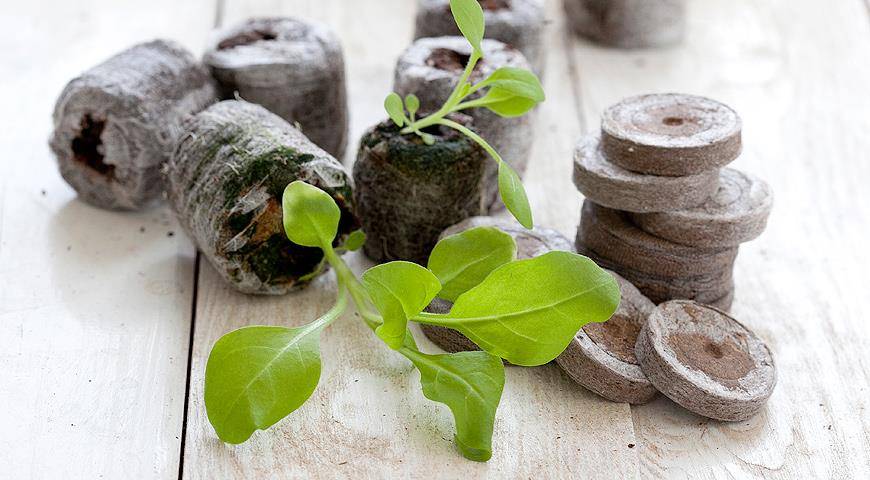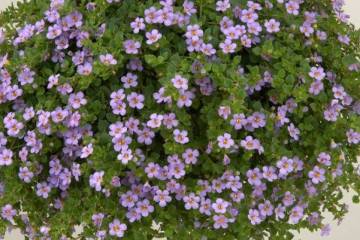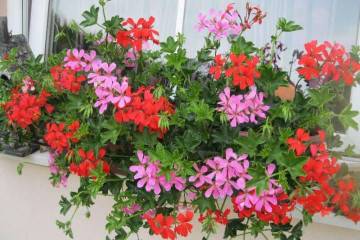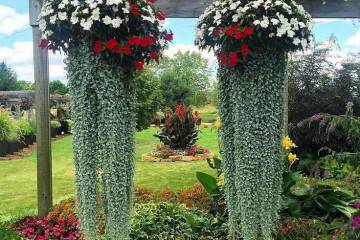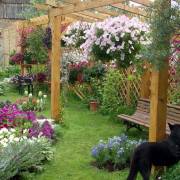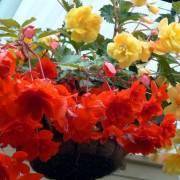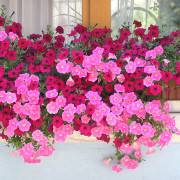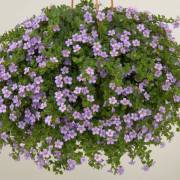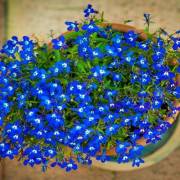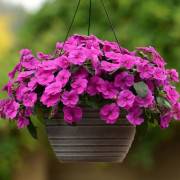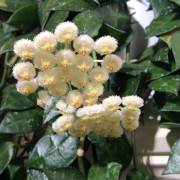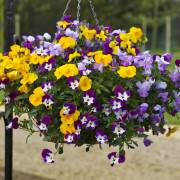Ampel petunia - growing in pots and care
Content:
Today on earth you will not meet a summer resident who would not be familiar with such a flower as petunia. Of particular interest are ampelous varieties. The length of their branches in warm latitudes can reach 2 meters. Petunia, although not picky, still requires attention and a special approach, therefore, further we will talk about the features of her cultivation and caring for her.
Features of caring for ampel petunias
Ampel petunias decorate balconies, terraces, gazebos in summer cottages.
In order for the territory to drown in the lush flowering of these plants, it is necessary to follow the most elementary care rules:
- Lighting. Ampel petunia needs abundant light. With its lack, the house plant will develop poorly and will begin to increase only the green mass, and will forget to think about flowers at all. Therefore, for a beauty, they choose either a well-lit area, or provide her with additional artificial light. However, on hot days it must be protected from the scorching sun rays.
- Temperature. The plant easily tolerates a sharp drop in temperature, but if it drops below zero, then the petunia will stop blooming and will go into hibernation.
- Watering. Ampel petunia is very fond of water, so it needs to be watered every day, and on dry days even 2 times a day. However, watering should be moderate, otherwise excessive moisture can lead to root rot. On cloudy days, plants can be watered every other day. To prevent water from stagnating, you need to put good drainage in the pot. Some summer residents recommend placing a sponge on the bottom, which absorbs moisture well.
- Top dressing. Regular use of fertilizers promotes abundant flowering, therefore, fertilizing should be applied about twice a month. Fertilizers are applied for the first time 2 weeks after planting. In the early stages, it is not recommended to use nitrogen fertilizers. It is better to give preference to dressings that contain phosphorus and potassium. They contribute to good and fulfilling development and growth.
- Loosening. In order for oxygen to easily and in sufficient quantities to reach the roots, the soil must be loosened regularly. However, this must be done with great care so as not to damage the root system.
- Pruning. It is very important to follow the shape of the flower, otherwise it will lose its decorative effect. If you ignore the pinching, then the petunia will slow down in growth and may stop blooming.
Since summer residents love to grow petunias in open areas, care must be taken to ensure that the flower is not attacked by pests such as spider mites, aphids and snails.
Against aphids and spider mites, flowers should be sprayed with soap or tobacco solution. To prevent snails from reaching the plants, you need to cover the soil around them with stones or eggshells, since they prevent the movement of these pests.
As for diseases, petunias are susceptible to mold damage, which can lead to root rot. To prevent this from happening, for preventive purposes, the soil is mixed with sand before planting, but this method does not give one hundred percent guarantee that it will be possible to avoid mold damage. To combat this disease, potassium permanganate is used, which is stirred with water.
To avoid a disease such as chlorosis, iron must be added to the water.This is especially important for white petunias, which most often suffer from this disease.
Growing petunias from seeds
This flower has very small seeds. In order for them to sprout, you need to provide them with nutritious soil. The soil should be light, loose and have neutral acidity.
For sowing, a shallow wide container is suitable, which is filled with soil, leaving a small (about 1 cm) side. In order for the seeds to be evenly distributed over the surface, they must be mixed with dry sand. After sowing, the soil should be moistened with a spray bottle. The container is covered with glass or foil and placed in a room where the temperature is not lower than +20 degrees. It is important not to forget to spray the soil. You can put the container in a tray with water, from which moisture will gradually enter the ground.
The first shoots appear in a week. The sprouts must be ventilated by opening the greenhouse for a while, otherwise they will be susceptible to various diseases.
Today, stores sell special granules in which producers place petunia seeds. These granules are a shell of nutrients, so it will be much easier to achieve a good harvest with them. In addition, it is easier to plant such "seeds" in the soil, since they are larger than the seed itself. The main thing is to prevent this granule from drying out, since this will destroy the seed and it will not germinate.
Experts often recommend planting the granules in peat tablets. For petunias, the best option is tablets, the diameter of which does not exceed 4 cm.It is not difficult to grow a flower in such an environment:
- Before planting, a peat tablet is soaked in water for 2 hours. You need to wait until it is completely swollen. If necessary, you can add water, and if there is excess, then drain.
- One granule is placed in each tablet using a match.
- After planting, the granules are sprayed with water until their shell turns into a slurry.
- After 5 minutes, the casing is gently smeared.
- The tablets are covered with foil.
Selection of ampel petunia seeds
When choosing petunia seeds, in no case should you be guided by the picture that is painted on the seed packaging. Manufacturers often embellish their product, so expectation and reality can be very different from each other.
When choosing seeds, you should focus on the following indicators:
- Variety. We need some kind of unusual specimen, for example, such as a large-flowered terry petunia or species that have a lush cap, it can be multiflora or surfiniya.
- Color. You can focus on your favorite shades or those that harmoniously fit into the interior or floral arrangement.
- Features of the species. There are plants that bloom later, and some earlier. Also, the varieties are distinguished by their resistance to bad weather conditions.
- Expiration dates. Petunia seeds are very sensitive, so if they have been harvested for a long time, their similarity will be deplorable.
- Manufacturer. There are firms that are more conscientious about the quality of their products, and there are those that do not really pay attention to it. Before buying, it is better to read a few reviews left by experienced growers, then it will be easier to decide on the manufacturer.
Growing ampelous petunias from seedlings
Before you start breeding these plants, you need to study well the issue of ampelous petunia growing and care (you can use the Internet). After that, you can go to the flower shop for seedlings.
In order for the planting material to begin and develop well, it is necessary to adhere to the recommendations of experienced florists:
- You need to plant seedlings in the evening, when there is no longer the scorching sun rays.
- Seedlings are planted on a flower bed together with an earthen lump in which it germinated in a pot.
- The size of the hole must be at least 10x10 cm.
- Ampel petunia bushes are planted at a distance of about 30 cm from each other.
- The soil around the seedlings is mulched with humus or peat. This will help protect the plants from cold temperatures.
- The planted flowers must be watered.
How to plant an ampelous petunia in a pots
In order for petunia to feel good in a flower pot, it is necessary to choose the right soil for it. To do this, mix equal amounts of sod soil with peat and add a baking powder to them 3 times less. If there is no opportunity or desire to prepare the soil for the plant yourself, then you can buy it ready-made in the store. Ampelous petunia planted in pots needs evening and morning watering.
When planting petunias in pots, care and cultivation are carried out according to the same rules as in the open field, but there are some nuances:
- the ampelous beauty is planted not in the center, but on the edge of the pot;
- hang the pots in a well-lit place, in the shade the petunia will not throw out the buds and will stop growing;
- you cannot place the plant in drafts.
Ampelous petunia pot volume
If we are talking about terry varieties, then a pot of about 3 liters will be enough for them, and for other ampelous species, about 5 liters should fall on one plant.
The number of petunias in a pot depends on its size. In a pots with a diameter of 30 cm, no more than 3 plants can be planted. It is not necessary to allow a thickened planting, otherwise the flowers will begin to ache and develop poorly. Petunia is one of those flowers that need space.
For ampelous petunias, both hanging plastic pots and flowerpots with high legs are chosen. The main thing is that they have holes for the outflow of water, since these varieties need abundant watering.
Formation of ampelous petunia
In order for a spectacular ampelous petunia to grow, care must be timely. The bush begins to form when the plant reaches 10 cm in height, and the shoots will stretch in different directions. You need to pinch off the top and the petunia will have side branches, the bush will become lush and beautiful, and lush flowers will begin to form.
When the plant reaches 15 cm, the pinching is repeated again. Torn branches can be used as propagation cuttings. To do this, they are put in water and wait until they put out the roots.
To get plants with lush greenery and lush flowering, you need to feed them regularly. This flower is in great need of useful trace elements and minerals, so some gardeners prefer to mix long-acting fertilizers into the soil before planting. And there are also experts who recommend adding liquid fertilizers to the water and using such a solution for irrigation.
In order for the plant to please with lush flowering, it needs to be provided with proper watering. For example, if we are talking about a long balcony flowerpot about 80 cm, then on hot days it will need to use from 4 to 6 liters of water.
You also need to pinch the plant above the fifth leaf. This promotes the appearance of side branches and lush flowers.
The petals of the petunia are very delicate and sensitive, so before the rain starts, the plants need to be hidden in a shelter.If this is not possible and the rain damaged the petals, then the affected flowers must be cut off, new buds will quickly appear in their place.
It is possible to achieve lush flowering in a summer cottage only by thoroughly studying the peculiarities of growing and caring for ampel petunia. If you follow all the rules, you can get a multi-colored area that will delight the eye and delight neighbors and passers-by.
